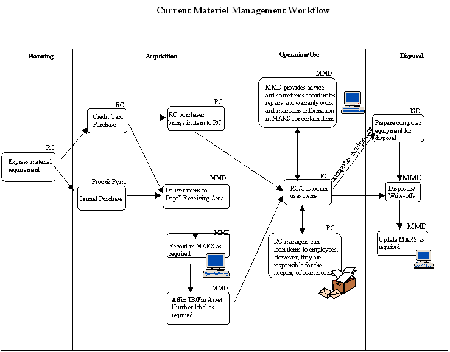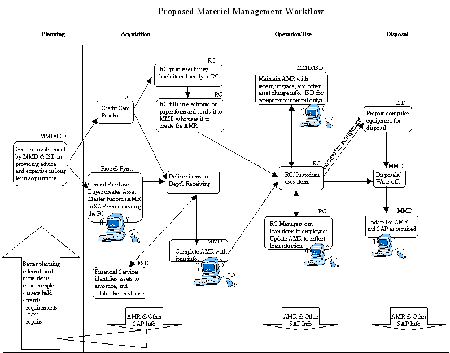Common menu bar links
Breadcrumb Trail
ARCHIVED - Department of Finance and Treasury Board Secretariat Draft Asset and Inventory Management Strategy
 This page has been archived.
This page has been archived.
Archived Content
Information identified as archived on the Web is for reference, research or recordkeeping purposes. It has not been altered or updated after the date of archiving. Web pages that are archived on the Web are not subject to the Government of Canada Web Standards. As per the Communications Policy of the Government of Canada, you can request alternate formats on the "Contact Us" page.
Prepared by Consulting and Audit Canada - April 1998
Executive Summary
The purpose of this Asset and Inventory Management Strategy is to establish a framework for the management of materiel within the IFMS/SAP environment (the Integrated Financial and Materiel System). The Strategy takes into account fundamental issues raised by the various stakeholders, such as planning, tracking requirements, inventory management, loans, acquisition cards, and facilities management. Asset and inventory management information constitutes the common thread amongst these fundamental issues, and thereby is the centrepiece of the Strategy.
Our study has included interviews with stakeholders in the Corporate Services Branch and in the Treasury Board Secretariat policy area. We have also taken into account major trends impacting on the materiel management area, such as the increasing popularity of acquisition cards. The following is an outline of the major sections of the report.
- A depiction of the Current Materiel Management Workflow is presented on page (v).
- A depiction of the Proposed Materiel Management Workflow model is presented on page (vi).
- A brief discussion and analysis of the trends and issues that have shaped our thinking, and key definitions, is presented in Sections 2 to 4 of this report. These Sections provide the rationale for our proposed Framework.
- A Draft Accountability Framework is presented in Section 5. The proposed Framework is supplemented by a Summary Responsibility Chart on page 17.
- Section 6 concludes the report with the identification of Next Steps that we see as a way to progress towards the proposed Framework.
This Strategy is based on the requirements and constraints expressed by TB/Fin stakeholders, in order to make the approach workable within the current environment. The Department of Finance and the Treasury Board Secretariat, like many other departments, have suffered from significant reductions in the administrative support functions, affecting the workload of remaining staff. However, the effective use of automation through the implementation of SAP, can make this strategy workable with available resources. Simplicity of design and current resourcing levels were taken into account in the design of the Strategy. The principal recommendations embedded in our strategy are presented in the following table:
|
Recommendation |
Suggested OPI |
Relating to Existing or New Assets |
| It is of our opinion that the next step in the implementation of the Draft Asset and Inventory Management Strategy should be to consult with all stakeholders in order to assess the workability of, and gain acceptance for, the proposed roles and responsibilities. | FSD | n/a |
| All acquisition card transactions over $500 would be flagged by Procurement and Payment Services, in order to capture all controllable assets. Arrangements would then be made to complete an Asset Master Record. This addresses one of the key concerns of the Office of the Auditor General in their recent audit of acquisition cards. | Proc. & Pymt. | New |
| All loans of materiel would be accounted for centrally, to limit TB/Fin's exposure to negative public perceptions due to ineffective controls over such materiel. A one-time inventory of items currently out on loan is required, as well as a system for capturing these in the future. | RC's, ASD-FMM, ISD | Existing and New |
| The MARS inventory system would be replaced by SAP, including the use of SAP's long text field in the Asset Master Records for capturing data on repairs and maintenance. | ASD-FMM, ISD | Existing and New |
| The threshold for capital assets should be set at $5,000 for financial reporting purposes. This, based on our discussions with TB officials, is not out of line with Treasury Board policy, and is a level used in the private sector as related to us by TB officials. Also, it does not impose an additional workload on TB/Fin. | FSD | Existing and New |
| For tracking and inventory control purposes, controllable assets are defined as items costing more than $1,000, and items of an attractive nature (Computer equipment - desktop and portable (monitors and CPU's), printers, fax machines, electronic overhead projection equipment, cellular phones, personal electronic organizers, televisions, video cassette recorders and other video equipment). | n/a | Existing and New |
| SAP should be used as the principal enabler to central asset management, in terms of tracking asset movement and repairs. | n/a | Existing and New |
| Responsibility Center staff would not have direct access to SAP for maintaining asset master records up to date, but would input the information through an Intranet interface. Although the concept of web-enabling SAP still has many unknowns at this time, it is of our opinion that, basically, RC's should not have direct access to the Asset Master Records, but merely input the asset information on an electronic form, which would be verified by ASD-FMM before it is uploaded to SAP. Until this is implemented, the input would have to be done through the use of paper forms. | RC's, FSD | New |
Significant government-wide initiatives such as the implementation of SAP and the increased use of acquisition cards, present concrete opportunities. The SAP system, once implemented in TB/Fin, will enable significant improvements in materiel management planning information, without the need for additional resources. For example, SAP provides an opportunity to phase out obsolete systems like MARS and introduce an enterprise system that eliminates duplicate entries and improves the quality of reporting.
Our Framework also offers a solution to one of the government-wide side effects of acquisition cards on materiel management, as highlighted by the Office of the Auditor General in his report on Acquisition Cards. Because items tend not to be recorded in central systems when purchased through acquisition cards, the quality of planning information gradually deteriorates in the long term as systems represent a gradually decreasing percentage of the total population of departmental assets. It is our understanding that, in TB/Fin, approximately 10% of transactions of more than $500 are made through acquisition cards. Our solution takes into account the need for relative simplicity required by this low transaction volume, as well as the risk of future deterioration of asset management information.
Our discussions have indicated that, from a departmental perspective, the planning of long term materiel acquisitions suffers from an information gap, as well as from a lack of integration with corporate planning, budgeting, real property, personnel and financial systems. Improvements in materiel management information and the implementation of SAP were seen, as a general consensus, as ways of facilitating materiel management planning. It is our understanding, based on our discussions with representatives of the Materiel Management Institute, that the discipline of materiel management is moving towards a more proactive role, including that of planning. Supported by better planning information and tighter linkages to corporate systems and structures, the materiel management function will be in a position to bring improvements to the way the Departments manage their assets.


